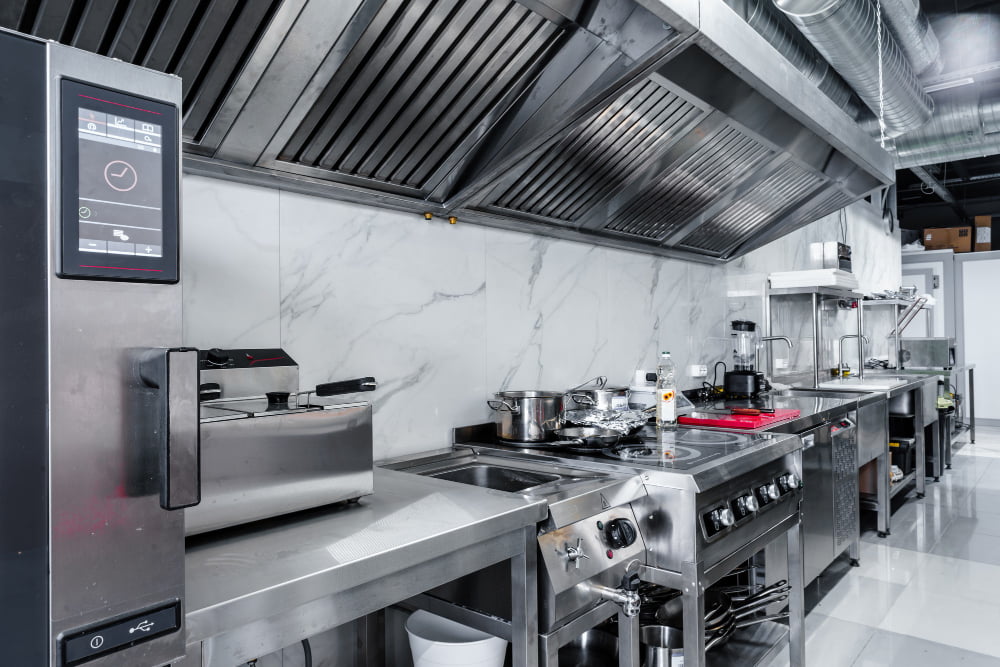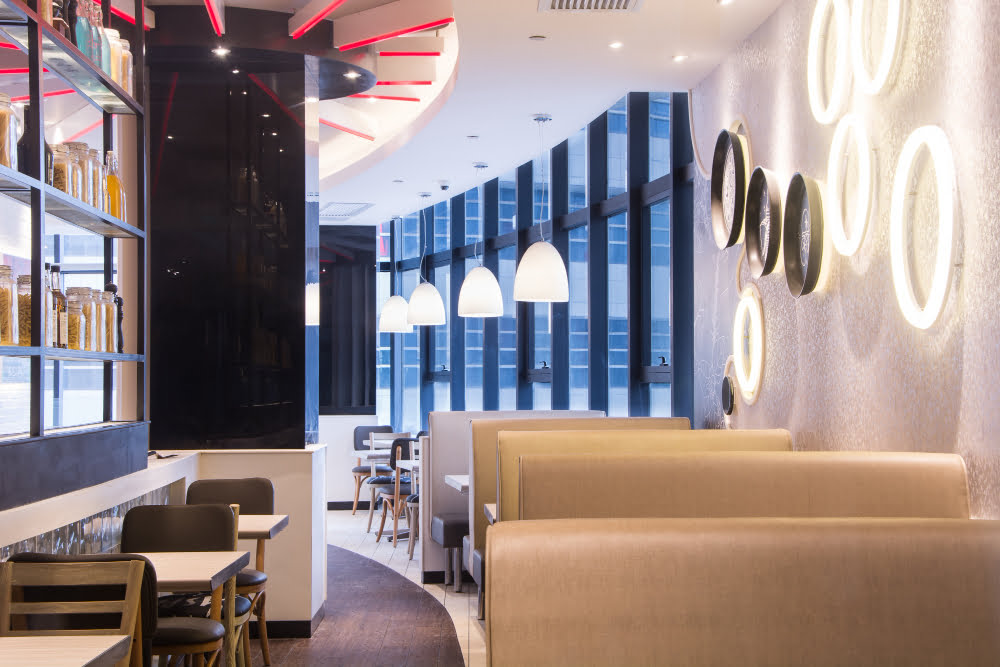For many restaurant owners, striking the right balance between aesthetic appeal and functional efficiency can be a daunting task. A restaurant’s ambiance plays a crucial role in the overall dining experience, influencing customer mood, perception, and ultimately, their decision to return.
However, beyond the visual appeal, the functionality of the space, especially in areas like the kitchen and seating arrangement, is equally important.
This article will guide you through key aspects of restaurant renovations, focusing on enhancing both ambiance and functionality to create a space that delights customers and operates smoothly.
Upgrading Your Commercial Kitchen

Efficient, safe, and compliant kitchen design can significantly improve workflow, safety, and overall functionality. When planning a kitchen renovation, consider the layout carefully to ensure that all areas are easily accessible and that there is a logical flow from preparation to cooking to plating.
This not only makes for a smoother operation but also reduces the risk of accidents. Up-to-date kitchen equipment that meets health and safety standards can prevent costly violations and ensure a safe working environment for your staff.
In essence, a well-designed kitchen is the backbone of a successful restaurant, ensuring that operations run smoothly and efficiently.
You can get more insights into planning a safe and compliant commercial kitchen by joining an association like Commercial Building Association. They offer commercial contracting insights to help you enhance the value, aesthetics, and functionality of your property.
Seating Arrangements: Comfort and Capacity
Seating arrangements can make or break the dining experience. The challenge is to maximize capacity without sacrificing comfort. Different seating layouts can serve different purposes; for instance, booths offer privacy and comfort, making them ideal for long meals, while high-top tables can turn over quickly, suited for bars or casual dining.
The type of furniture chosen should match the restaurant’s theme and be comfortable enough to keep customers coming back. It’s also essential to consider accessibility when planning seating arrangements, ensuring that there is enough space for all customers, including those with disabilities.
Thoughtful seating arrangements enhance the dining experience by making customers feel welcome and comfortable.
Improving Lighting for Better Atmosphere

Lighting is a powerful tool in setting the mood and enhancing the overall atmosphere of a restaurant. The right lighting can create a warm, inviting environment that enhances the dining experience.
For example, soft, warm lighting can create a cozy, intimate feel, while bright, cool lighting can energize the space and make it feel more open. By strategically planning your lighting, you can create a space that not only looks good but also feels good to be in.
Acoustics: Managing Noise Levels
One often overlooked aspect of restaurant design is acoustics. Managing noise levels is essential for creating a pleasant dining experience. Too much noise can make it difficult for customers to have a conversation, leading to frustration and a less enjoyable experience.
On the other hand, a space that is too quiet can feel sterile and unwelcoming. The key is to find a balance that allows for lively conversation without overwhelming noise. This can be achieved through the use of sound-absorbing materials like carpets, curtains, and acoustic panels.
Additionally, designing the space to minimize noise reflection and focusing on creating quiet zones can help manage noise levels effectively. Good acoustics contribute to a comfortable and enjoyable dining environment, encouraging customers to stay longer and return more often.
Restroom Renovations: Enhancing Hygiene and Accessibility
A restaurant’s restroom often leaves a lasting impression on customers, sometimes even more than the dining area itself. Clean, hygienic, and accessible restrooms are not just a luxury but a necessity. They reflect the overall standards of the establishment and show that the management cares about its patrons’ comfort and health.
When renovating restrooms, prioritize hygiene by choosing easy-to-clean surfaces and touchless fixtures like automatic faucets and flush systems. These features help maintain cleanliness and reduce the spread of germs.
Accessibility is equally important; ensure that restrooms comply with ADA guidelines, providing adequate space and necessary facilities for customers with disabilities. By investing in restroom renovations, you can significantly enhance the customer experience and promote a positive image of your restaurant.
Choosing the Right Color Palette for a Memorable Experience
The color palette of your restaurant plays a crucial role in setting the mood and influencing customer behavior. Different colors evoke different emotions and can impact dining habits.
For instance, warm colors like red and orange can stimulate appetite and create a lively atmosphere, while cool colors like blue and green can induce relaxation and calmness. When choosing a color scheme, consider the type of dining experience you want to create.
Also, ensure that the colors complement your brand and theme. Incorporate accent colors strategically to highlight certain areas and create visual interest. A well-chosen color palette can make your restaurant more inviting and memorable, encouraging customers to return.
Integrating Technology for a Modern Touch
Incorporating modern technology into your restaurant can enhance both the dining experience and operational efficiency. Technology can streamline processes, improve service, and even create a unique dining atmosphere.
For instance, modern POS systems can speed up order processing and reduce errors, while digital menus and ordering systems can enhance convenience for customers. Additionally, incorporating technology in the ambiance, such as using LED screens for dynamic decor or interactive tables, can make the dining experience more engaging.
However, it’s important to integrate technology seamlessly so that it enhances rather than detracts from the overall ambiance. Thoughtfully implemented technology can make your restaurant stand out in a competitive market.
Outdoor Dining Spaces: Creating an Inviting Atmosphere
Outdoor dining spaces have become increasingly popular, especially in the wake of the COVID-19 pandemic. They offer a safe and enjoyable dining option, allowing customers to enjoy their meals in an open-air environment.
When designing an outdoor dining area, consider factors such as weather conditions, privacy, and comfort. Use weather-resistant furniture and provide shade options like umbrellas or awnings to protect customers from the elements.
Incorporate greenery and natural elements to create a relaxing and visually appealing space. Additionally, ensure that the outdoor area is well-lit for evening dining and has adequate heating for cooler weather. An inviting outdoor dining space can attract more customers and enhance their dining experience.
The Takeaway
Renovating a restaurant is a significant investment, but it can pay off immensely by enhancing both ambiance and functionality. By carefully planning each aspect of the renovation, from upgrading the kitchen and restrooms to choosing the right color palette and integrating modern technology, you can create a space that delights customers and operates efficiently.
Managing noise levels and creating inviting outdoor dining spaces further contribute to a memorable dining experience. Sustainable renovation choices not only appeal to eco-conscious diners but also help reduce operating costs.
Ultimately, a well-renovated restaurant can boost customer satisfaction, encourage repeat visits, and set the stage for long-term success. Embrace the renovation process as an opportunity to transform your restaurant into a place that people love to visit.